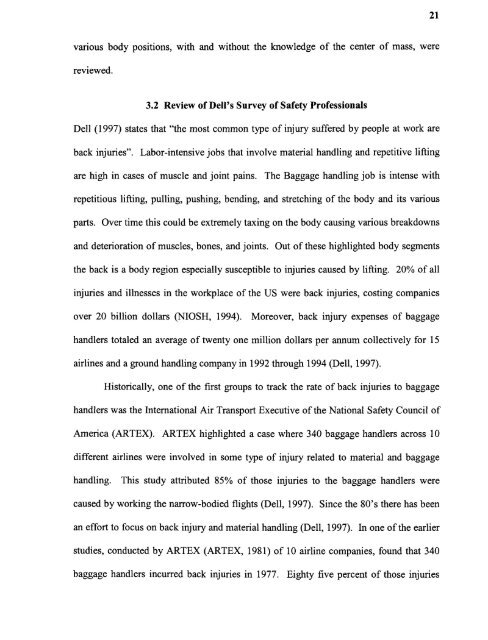An ergonomic assessment of the airline baggage handler
An ergonomic assessment of the airline baggage handler
An ergonomic assessment of the airline baggage handler
Create successful ePaper yourself
Turn your PDF publications into a flip-book with our unique Google optimized e-Paper software.
21various body positions, with and without <strong>the</strong> knowledge <strong>of</strong> <strong>the</strong> center <strong>of</strong> mass, werereviewed.3.2 Review <strong>of</strong> Dell's Survey <strong>of</strong> Safety Pr<strong>of</strong>essionalsDell (1997) states that "<strong>the</strong> most common type <strong>of</strong> injury suffered by people at work areback injuries". Labor-intensive jobs that involve material handling and repetitive liftingare high in cases <strong>of</strong> muscle and joint pains. The Baggage handling job is intense withrepetitious lifting, pulling, pushing, bending, and stretching <strong>of</strong> <strong>the</strong> body and its variousparts. Over time this could be extremely taxing on <strong>the</strong> body causing various breakdownsand deterioration <strong>of</strong> muscles, bones, and joints. Out <strong>of</strong> <strong>the</strong>se highlighted body segments<strong>the</strong> back is a body region especially susceptible to injuries caused by lifting. 20% <strong>of</strong> allinjuries and illnesses in <strong>the</strong> workplace <strong>of</strong> <strong>the</strong> US were back injuries, costing companiesover 20 billion dollars (NIOSH, 1994). Moreover, back injury expenses <strong>of</strong> <strong>baggage</strong><strong>handler</strong>s totaled an average <strong>of</strong> twenty one million dollars per annum collectively for 15<strong>airline</strong>s and a ground handling company in 1992 through 1994 (Dell, 1997).Historically, one <strong>of</strong> <strong>the</strong> first groups to track <strong>the</strong> rate <strong>of</strong> back injuries to <strong>baggage</strong><strong>handler</strong>s was <strong>the</strong> International Air Transport Executive <strong>of</strong> <strong>the</strong> National Safety Council <strong>of</strong>America (ARTEX). ARTEX highlighted a case where 340 <strong>baggage</strong> <strong>handler</strong>s across 10different <strong>airline</strong>s were involved in some type <strong>of</strong> injury related to material and <strong>baggage</strong>handling. This study attributed 85% <strong>of</strong> those injuries to <strong>the</strong> <strong>baggage</strong> <strong>handler</strong>s werecaused by working <strong>the</strong> narrow-bodied flights (Dell, 1997). Since <strong>the</strong> 80's <strong>the</strong>re has beenan effort to focus on back injury and material handling (Dell, 1997). In one <strong>of</strong> <strong>the</strong> earlierstudies, conducted by ARTEX (ARTEX, 1981) <strong>of</strong> 10 <strong>airline</strong> companies, found that 340<strong>baggage</strong> <strong>handler</strong>s incurred back injuries in 1977. Eighty five percent <strong>of</strong> those injuries
















